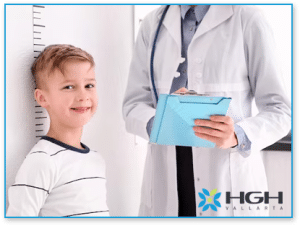Situated close to the base of the brain and joined to the hypothalamus are growth hormones which are actually proteins that the pituitary gland produces.
The part of the brain in charge of the pituitary gland that secretes the growth hormones is the hypothalamus. Growth hormones will not be produced if the hypothalamus or pituitary gland is not functioning as it should- a condition referred to as HGH deficiency.
Its Effect On Children
Growth is a gradual process and children develop at various rates; this makes the effect of growth hormone deficiency difficult to recognize. Notwithstanding, HGH deficiency in children have immature appearance among their peers and have younger and rounder faces.
Despite the fact that their body proportion is normal, they may be chubby or have what is termed ‘baby fat’ around their abdomen. In some cases, they have underdeveloped bridge of the nose; but it is important to note that the growth deficiency have no effect on the child’s intelligence.
HGH Deficiency in Boys
This deficiency can cause reduction of the male penis; a condition known as micro penis.
There would be an unusual poor growth even to the puberty level for the child.
HGH Deficiency in Girls
Likewise, they may or may not experience puberty at all and in some cases breast may not develop at the right time.
Generally, many teens with growth hormone deficiency experience low self-esteem due to developmental delays and variety of psychological symptoms can occur including:
- Depression
- Lack of concentration
- Poor memory
- Bouts of anxiety
- Emotional distress
How To Treat
Different children have specific treatment that is administered to them for growth hormone deficiency by the doctor and it depends on the child’s age, general wellbeing, restorative history, degree of the condition, resistance to particular pharmaceuticals, techniques, or treatments, desires for the course of the condition and then the parents’ discretion.
After diagnosis, treatment for the condition includes consistent infusions of human development hormone. While some children get day by day infusions, others get injected a few times each week.
Treatment for most part keeps going on and the outcomes are frequently observed after three to four months after the infusions had begun. Be it as it may, not all children react well to development hormone treatment.

Why it is Important to Treat
Based on the fact that some children are diagnosed with growth hormone deficiency, there is a lot of tendency that the child might experience psychological set back as a result of societal programming that places so much precedence on body stature.
Deliberate support for such children is very vital; and helping them focus on their numerous great and important qualities, so that the stature of the child does not restrict his or her progress.
More psychosocial adjustment to short stature can be gained from guardians of short children and from development facility specialist, medical attendant and therapist.
Most times, children that are short for their age have issues since companions and educators regard them as if they are kids instead of being simply short. Guardians have a tendency to do this as well and make it obvious that they love their other children more.
These children at that point may not behave well and start acting in a way that is not expected of them. Some of these issues might be avoided by blunt and open dialog with instructors and peers.
Ways to Treat HGH Deficiency
Human growth deficiency is majorly treated for children through growth hormone replacement therapy. HGH deficiency in children can benefit from growth hormone replacement therapy and enjoy enhanced growth as a result. Recombinant human growth hormone therapy (rhGH) is given by every day subcutaneous infusions.
Children and their families are also educated to self-infuse rhGH at home. The initial rhGH dosage depends on the child’s weight and might be used with therapy such that an eye is kept on weight gain, growth reaction and IGF-1 levels. Children getting rhGH therapy ought to be seen by the pediatric endocrinologist at least 3 to 6 months for proper observation of the growth and change of the rhGH measurements.
The faster a child is diagnosed, the better; and the higher the chance of still having a proper height and the higher the probability that the child will achieve a stature that is typical for a grown-up.
A few children with extreme growth hormone deficiency will require rhGH therapy as grown-ups because of the metabolic impacts of growth hormone. Surgery can also be done on the pituitary gland for the treatment of growth hormone deficiency. Radiation therapy can also be applied to the pituitary gland if the surgery for tumor cannot be accomplished safely.

What happens when it’s not Treated
Total body fat increases as well as abdominal fat associated with the hormone deficiency and the implication of this is that this ensures that children who do not get treatment at their young age are prone to the risk of heart diseases when they grow up
Triglycerides and low-density-lipoprotein cholesterol present in the blood tends to be high in a way that is not close to normal and the risk of cardiovascular disease in middle age or later is high due to lipid levels that is abnormal in early adulthood.
There is a great danger if a child who is diagnosed with growth deficiency is not treated properly. Tendency for that child’s growth into proper adulthood stature is already cut short and not too feasible. This can affect the child’s social life thereby stripping such child of the opportunity to have a normal transition from childhood to adulthood.
Other Information 
Things to watch out for to guarantee effective administration of GH therapy for children with GHD include:
- Aversion of HGH deficiency in children when possible
- Early distinguishing proof and commencement of GH treatment when a child is still young
- Adherence to the endorsed therapy
- Alteration of GH measurement on the child to accomplish the targeted result.











